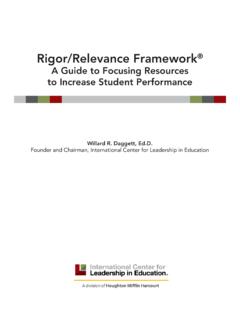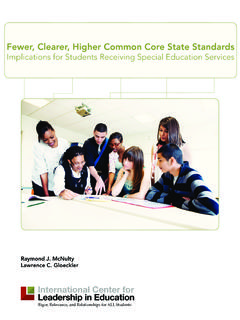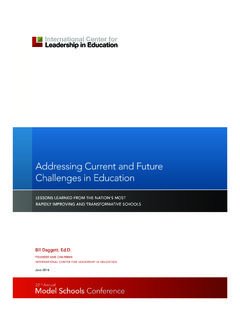Transcription of The Daggett System for Effective Instruction - ICLE
1 The Daggett System for Effective Instruction Where Research and Best Practices Meet Willard R. Daggett , Founder and Chairman, International Center for Leadership in Education The Daggett System for Effective Instruction Where Research and Best Practices Meet Converging Challenges As Western nations struggle to recover their economic equilibriums after the financial crisis of 2008, China and India are leveraging their size and human capital to become global economic powerhouses. Emerging economies such as Vietnam, Argentina, Brazil, Indonesia, and Panama are increasingly capable of winning greater shares of international business. The ability to compete in the interconnected global economy is primarily leveraged by technical innovation and a highly-skilled workforce. A more rigorous and more applied education curriculum is needed to drive both levers.
2 While our schools are working hard at improving, the reality is that the rest of the world is changing faster, leaving a growing gap. In an effort to close the gap, state-supported initiatives for raising standards and measuring student achievement will require schools to change what and how they teach. The fewer, clearer, higher Common Core State Standards (CCSS), anchored by the Next Generation Assessments (NGA), will raise the bar for most states to help ensure that every student is challenged to achieve and succeed. Proficiency levels will be set higher. Assessment will measure not just what students know, but also what they can do with that knowledge. Most schools involved with Race to the Top (RttT) initiatives will need awareness building, planning, time, and support to realize the mandatory 2014-2015 implementation dates of the new learning expectations represented by the CCSS and NGA.
3 These challenges are driving a greater focus on accountability and a growing demand for proof of effectiveness and efficiency in public education. If No Child Left Behind's Adequate Yearly Progress (AYP). provision laid accountability for results on the backs of principals, today's education policy, including measures such as growth models and teacher effectiveness evaluations, is shifting the burden of accountability to teachers. What Works Analysis of the Research Recognizing the challenges facing schools today is easy. Identifying the most Effective ways to address them is not. Education research is plentiful and comprehensive, so much so that studies are available to prove or disprove almost any decision made by education leadership. However, most of the respected research is consistent on one key school improvement issue: Effective Instruction really matters.
4 No single variable has more impact than teaching. Copyright June 2011, January 2014 by International Center for Leadership in Education. All rights reserved. 1. Hattie's Visible Learning Several significant research studies have particularly informed the Daggett System for Effective Instruction (DSEI). One is John Hattie's Visible Learning: A Synthesis of Over 800 Meta-Analyses Relating to Achievement. Hattie analyzed 200,000 effect sizes (the relative impact of one factor compared to other factors) from 52,637 studies involving more than 50 million students and covering an exhaustive number of factors. Hattie's approach was that effect sizes are the best way to identify what has the greatest influence on student learning. The calculations behind his work are complex, but to simplify an effect-size of (defined as an increase of one standard deviation) is typically associated with the equivalent of approximately two years of growth in one year Hattie's analysis shows that most variables in schools have an effect size of around + or + , what Hattie calls his hinge point.
5 Any factor below + is of lower value. Factors below have negative effects. Some factors can be directly affected by an education organization; others cannot. Some noteworthy effect sizes from his research include: Formative Evaluation: + (~ years of growth). Providing feedback: + (~ years of growth). Student Teacher Relationships: + (~ years of growth). Prior Achievement: + (~ years of growth). Professional Development: + (~ years of growth). Socioeconomic Status: +0 .57 (~ years of growth). Peer Tutoring: + (~ years of growth). Teaching Test-taking: + Reducing class size: + On the other hand, certain factors have negative impact. Mobility: = years loss InTASC Model Core Teaching Standards Another publication that greatly influenced the Daggett System for Effective Instruction is InTASC Model Core Teaching Standards: A Resource for State Dialogue.
6 Developed by the Council of Chief State School Officers (CCSSO), it outlines the common principles and foundations of teaching practice that cut across all subject areas and grade levels and that are necessary to improve student achievement. Sutton Trust Toolkit of Strategies to Improve Learning The goal of this United Kingdom study, published in May 2011, was to help schools determine which research-proven instructional practices were most Effective in supporting students from economically disadvantaged backgrounds and at what levels of relative costs, even though there is no direct link between spending on schools and outcomes for pupils. The findings closely parallel Hattie's meta- analysis of instructional effectiveness and also reflect the intent of the International Center's Efficiency and Effectiveness Framework, correlating effectiveness and cost, as described later.
7 Copyright June 2011, January 2014 by International Center for Leadership in Education. All rights reserved. 2. Work of Robert Marzano Robert Marzano's extensive work focuses mainly on Instruction , including 41 Key Strategies Identified by Research for Effective Teaching and What Works in Schools Translating Research into Action. As he states in The Art and Science of Teaching, No amount of further research will provide an airtight model of Instruction . The best research can do is tell us which strategies have a good chance ( , high probability) of working well with students.. Charlotte Danielson's The Framework for Teaching The Framework for Teaching is a research-based set of components of Instruction that divides the complex activity of teaching into 22 components. Focused on Student Success: A Five-Year Research Study of Models, Networks, and Policies to Support and Sustain Rigor and Relevance for ALL Students The study revealed five key themes, all of which were used in the development of the Daggett System .
8 1. Leadership: A clear sense of purpose that empowers staff toward a common vision. 2. High expectations: For academic performance as well as college/career readiness. 3. Relationships: Valuing relationships as part of a successful learning environment. 4. Student opportunities: Both academic stretch and personal skill development opportunities. 5. Professional culture: Teachers, administration, and staff collaborate toward goals. It Takes a System , Not Just a Teacher Research supports what most of us see as common sense: what goes on between the teacher and the each student is central to high-level learning. Effective teaching is not the end goal, however; it is the means to an end: student achievement. Nevertheless, all teaching is more Effective when effectively supported. Achieving the goal of improving Instruction requires a supportive and aligned System .
9 Stated another way, although Effective teaching is essential, it is not sufficient to maximize achievement for all students. This understanding of the need for an organization-wide commitment is at the heart of the Daggett System . Daggett System for Effective Instruction For decades, the International Center has been an active observer of and participant in education reform. The International Center's on the ground work with schools has reinforced that it takes an entire System to develop, maintain, and enhance Effective Instruction . Teachers must be supported by instructional leadership and organizational leadership. Copyright June 2011, January 2014 by International Center for Leadership in Education. All rights reserved. 3. The Daggett System has been significantly informed by: 1. Observing and disseminating best practices.
10 For more than 20 years, the International Center has been assisting leadership and teachers, as well as identifying, studying, and showcasing America's most successful schools including its CCSSO-co-sponsored Bill & Melinda Gates Foundation-funded research on thousands of America's most Effective and most rapidly improving exemplar schools and school districts at the annual Model Schools Conference and other events. 2. Current and past research conducted by some of the most respected thought-leaders in K-12. education, as described previously. At the same time, the Daggett System departs from some of the existing models and frameworks for teaching in several significant ways. Traditional Teaching Frameworks Daggett System for Effective Instruction What teachers should do What the entire System should do Teacher-focused Student-focused Teachers deliver Instruction Teachers facilitate learning Vision is set by top leaders Vision is built more inclusively Define vision primarily in terms of Define vision as strong academics and academic measures personal skills and the ability to apply them Rigid structures support adult needs Flexible structures support student needs Focus on teaching Focus on learning Other models are excellent guides and tools for what they choose to focus upon, primarily teachers'.













